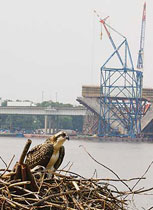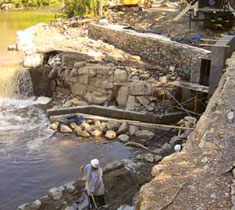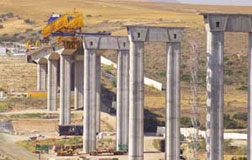In 2002, Arizona Dept. of Transportation engineers sincerely thought they were being context-sensitive. Their $45-million proposal to four-lane nine miles of State Route 179 in Sedona provided for deer crossings, stained rocks and replanted cacti. Then at a fateful meeting, Sedona residents “ripped into me,” recalls Debra Brisk, former ADOT deputy director and now transportation sector manager with HDR Inc., Omaha. “They were right,” she says. “We were just looking at it as mitigation. But it’s beyond that.”
So ADOT started over. A panel with citizens and federal officials helped choose a consultant team. “We did all that before we even looked at the [building] alternatives,” says Steve O’Brien, corridor manager for lead consultant DMJM+Harris, Los Angeles. The process included simulation models, setting core values and gathering suggestions, not just soliciting comments. The now-$55-million, 14-mile link to Interstate 17 is set to break ground this fall, with raised medians, improved crossings, turning pockets and bifurcated sections. “The extent of the process may not be appropriate for every project, but I’d hope that in some form it becomes a standard for the way we engineers do things,” says O’Brien.
 |
| Communication. DMJMs OBrien talks with Sedona local about road. (Photo courtesy of DMJM) |
That seems inevitable. Unlike the federally mandated Interstate construction 50 years ago, highway projects are now increasingly dependent on the financial and moral support of the communities they affect. “When the Interstate system was authorized 50 years ago, the task was to get it built as quickly as possible,” says Mary Peters, former Federal Highway Administration chief, now a senior vice president with HDR.
While engineers did that task and did it very well, times and expectations have changed. Paul Morris, managing principal of PB PlaceMaking, a unit of Parsons Brinckerhoff, New York City, notes that highways were once built “for the sole purpose of providing connectivity. In many cases, they did this at the expense of communities.”
Now, “the key facet is developing a project that is responsive to the community’s needs and allows it to grow and be vibrant,” says Mike Carragher, senior vice president of transportation with Vanasse Hangen Brustlin Inc., Watertown, Mass. Doing that requires engineers to take public outreach to new levels, contractors to tackle a broader range of on-site tasks—and state DOTs to not only embrace but integrate context-sensitive solutions.
In 1998, the American Association of State Highway and Transportation Officials, FHWA and the Maryland Dept. of Transportation hosted a conference called “Thinking Beyond the Pavement,” where the term “context-sensitive solutions” (CSS) was born. CSS “has come a long way since, but there are still difficulties in fully understanding and embedding it,” says PB’s Morris. In the beginning, “there was a natural tendency to want to formulize it” or even resist it. But over the past five to seven years, “enough projects have been built with CSS so as to illustrate a spectrum of applications,” he says.
The 36-year-old National Environmental Policy Act (NEPA) provided a good start to the new era of highway building. But HDR’s Peters says there are flaws. “We’ve become terrified that we’ll face lawsuits and have to provide nth-degree level of details,” she says. Hal Kassoff, PB senior vice president and former Maryland state transportation chief, points out NEPA improvements in new highway bill legislation, including a restriction of the window for project litigation to 180 days. Still, for a new generation of highway project deliverers, simply following NEPA is not enough. They must dabble in diplomacy, history, biology, economics and even landlordship.
|
Planning and Politics
The Sedona experience constitutes one early CSS milestone. More are proliferating. Utah’s Dept. of Transportation forged a deal with the Sierra Club on the Legacy Parkway, a $685-million, four-lane, 14-mile route from I-215 to I-15/U.S. Highway 89. After a five-year delay, bids will be opened in August.
The Sierra Club and residents sued to stop work in 2001. Since then, the parkway cost has increased by $217 million. “We could have said we’re going to court again, spent another two to three years and another $100 million and maybe won,” says Lt. Gov. Gary Herbert (R).
Instead, the parkway has become a model of public-private cooperation. Design consultant Carter & Burgess Inc., Fort Worth, incorporated public feedback as part of an out-of-court settlement reached in October. The deal sets a 55-mph speed limit, adds noise-reducing pavement and landscaping, and restricts trucks. It adds 125 acres of wetlands and commits $2.5 million to a transit study.
 |
| Public Vote. Georgia DOT goes extra mile for public outreach. (Photo courtesy of Georgia Department of Transportation) |
As part of the “holistic” trend, highways are no longer the only consideration for a travel corridor. In Georgia, planning for the I-75 Northwest Corridor includes bus rapid transit. “The approach we are taking spans not just the normal considerations but also the land development plan,” says Darryl VanMeter, Georgia Dept. of Transportation program manager. “It is both a highway and a transit project, which changes the feel.” Extra cost isn’t automatic—thanks to public input, two BRT stops were actually removed.
With new methods, engineers hope to nip lawsuits and delays in the bud. One method is environmental tiering, done for Virginia’s I-81 expansion. “It sets up a two-stage process for compliance with environmental quality regulations, says Frank Bracaglia, VHB senior project manager. “The first document is a broader look at what you’re trying to accomplish. Tier 2 provides details on specific issues. What happens sometimes is that smaller issues take precedence over big-picture ones, delaying the project.”
Splitting the 325-mile I-81 corridor into eight segments to be built over a 10-year period constitutes the big picture. “It doesn’t make sense to do a traditional EIS for a segment of a corridor that will be built years later,” says Bracaglia. “By tiering, you can decide what to do when.”
 |
| Contextual. Florida toll booth design is a result of public consensus. (Photo courtesy of Miami-Dade Expressway Authority/Servando Parapar) |
Sometimes the public has to be coaxed into early participation. “One of the main challenges facing our districts is, ‘how do you get people to the meetings and to provide input when a project is 25 years out?’” says Rusty Ennemoser, public involvement coordinator for the Florida Dept. of Transportation. “People tend to want to get involved when the bulldozers show up and it’s too late.” FDOT is using GPS technology plus census data and environmental maps to aid preliminary studies of the potential socioeconomic and environmental impact of corridors, says Ennemoser.
For I-75, GDOT used aerial maps to optimally locate signs announcing meetings and to pinpoint work locations, and the Internet for outreach and feedback. “In this particular corridor, we have close to 1,600 people working on the outreach,” VanMeter says. Looping video presentations help meeting attendees get a better grasp of the project.
Quantm Ltd., an Australian technology firm, is winning U.S. clients with software that expedites analysis of project alternatives and impacts. “The client provides raw data to us and we integrate and accelerate the analysis,” says creator Peter Gipps. He claims the system completes analyses up to two weeks faster than conventional means and helps optimize costs.
The software quickly detects potential impacts, creates virtual images from different viewpoints along the route and does life-cycle cost analysis. In one case, it helped reduce EIS costs by 35%, the firm says. In another, it allowed for reduction of wetlands impact by 50%. “It proved helpful in working with federal agencies,” adds Cathy Bechtel, project delivery director for California’s Riverside County Transportation Commission, which did a major investment study for its SR 91 project route.
Creeks and Critters
While immediate CSS impacts are seen in design, “it translates down to the contractor, no two ways about it,” says Brian Deery, senior director of the highway and transportation division of Associated General Contractors. The $2.4-billion Woodrow Wilson Bridge project is one example. “One of the things we often mistakenly think is that CSS is focused [only] in the design phase,” says Maryland State Highway Administrator Neil Pedersen. “We are thinking about how we can incorporate them in construction.”
 |  |
| Fish and Birds. Wilson Bridge project workers build fish paths and hatcheries as part of job. (Photo courtesy of Potomac Crossing Consultants) | |
One construction CSS on the Wilson bridge project was an air bubble curtain system to help dissipate the shock of pile-driving on fish (ENR 1/31/05 p. 26). In a $50-million environmental effort, crews are mitigating hundreds of acres of wetlands, forest and aquatic vegetation and building an 80-acre bald-eagle sanctuary. They also built step-pool structures to help fish travel upstream to spawn, says Tim Morris, environmental mitigation manager with Potomac Crossing Consultants, the general engineering consultant. Upper waters are stocked with fertilized fish eggs to “genetically condition” fish to spawn there again.
Bald eagle, peregrine falcon and osprey surround the site, creating constraints on project scope. In 2004, an osprey nested on a mooring pile, forcing workers to stay off it for five months. Falcons nest in existing bridge beams. Yet, “when I talk to the contractors and management staff, they seem to have this special feeling that these are our mascots,” says Stephanie Spears, PCC senior environmental specialist. “The stereotype of guys in the field being non-environmental stewards and not caring about anything other than steel and concrete just doesn’t apply [here].”
 |
| Mitigate. Segmental construction has less environmental impact in Otay Valley. (Photos courtesy of Porter Novelli) |
Birds, butterflies and wetlands spurred the use of precast segmental construction for San Diego’s 3,300-ft-long Otay River Bridge, part of the $635-million South Bay Expressway private toll road—just one of two major segmental bridges in California, says Dave Hawley, executive vice president of construction for developer Macquarie Infrastructure Group. Public-private collaboration resulted in the decision, adds D. Richard Linford, project director for the design-build joint venture of Washington Group and Fluor Corp., which is launching 640 segments 185 ft over the valley.
CSS undoubtedly adds layers of work to a project, but Pedersen says it’s worth it. “What we were finding with complex and controversial projects is that we were typically getting delayed anyway,” he says. “I couldn’t imagine us going back to the way we used to do business.”
On the Wilson Bridge project, Virginia Dept. of Transportation crews are focused on keeping area humans happy. In Alexandria, VDOT set up a neighborhood task force and held forums. Based on these, contractors adjusted schedules to accommodate congestion and noise concerns. “The task force is something we would not...

Post a comment to this article
Report Abusive Comment